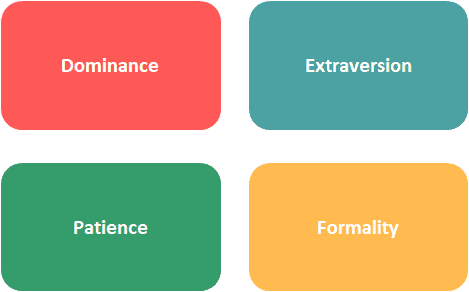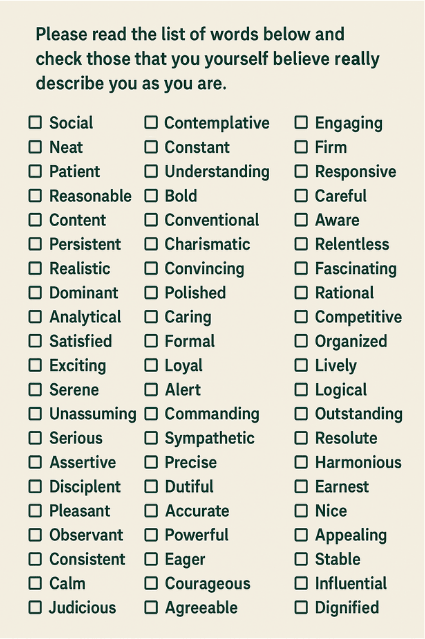Trusted by over 3,500 Candidates
Last Updated: August 7, 2025
The Predictive Index (PI) is a ubiquitous and well-regarded publisher of both cognitive and personality tests.
There are two PI assessments:
- The PI Behavioral Assessment - a personality test.
- The Predictive Index Learning Indicator (PI LI) - a cognitive ability test.
This page includes free PI Behavioral assessment practice questions taken from our preparation. JobTestPrep offers a comprehensive PrepPack with all the necessary materials aimed at helping you ace your test. Click to start now.
Learn More about the PI Cognitive Assessment.
What is the Predictive Index Behavioral Assessment?
The Predictive Index Behavioral Assessment [Also known as the PI Personality Index test] is a personality test where you select adjectives from two lists of 86 adjectives.
Based on your selections, you’ll be assigned one of 17 personality types. This profile offers insights into your expected behavior in the workplace.
There are two kinds of PI Behavioral questions:
- First list: Choose adjectives that describe how you believe others expect you to behave.
- Second list: Select adjectives that reflect how you see yourself.
4 Key Factors
Each of the 86 adjectives in the Predictive Index test relates to one of four key factors. Together, these factors describe the expected behavioral tendencies and traits in relation to the desired position:

- Dominance: Represents the drive to exert influence on people or events.
- Extraversion: Represents the drive for social interactions with others.
- Patience: Represents the drive for consistency and stability.
- Formality: Represents the drive to conform to rules and structure.
Let's take a look at an example.
Predictive Index Behavioral Question
See if you can recognize which adjectives indicate high patience on the Predictive Index Test:
An important thing to know about the PI behavioral test is that both the scoring and the questions vary depending on the role you're applying for. In the next section, we'll look at some examples.
PI Behavioral Assessment Practice Test Questions
Below is a review of several positions and their appropriate adjectives based on the 4 factors.
The results of the PI Behavioral Personality test are compared to an ideal profile for the role to evaluate the candidate's compatibility and predict how well he will perform in the job.
A high score on the test suggests that his traits align with the needs of the position.
Scroll down to view sample questions for different types of roles.
Team Leader/ Manager
Successful team leaders must be highly dominant, guiding and leading a team toward meeting company objectives. Excellent interpersonal skills are essential for building trust and effectively communicating with senior management and team members. The ability to foster a collaborative and efficient work environment is also essential.
What adjectives fit most for team leaders?
Headed toward a managerial position? Learn all you need about Leadership Assessment Tests. You can also check out our Hogan Assessment Tests and HPI Practice Test.
Public Relations Specialist
In public relations, staying attuned to evolving public sentiment and media landscapes is key. The role is highly relational, requiring connecting with various stakeholders like media and influencers. A congenial attitude is often crucial, especially when delicately handling crises. It blends awareness, social savvy, and approachability to shape an organization's public image.
What adjectives fit most for public relations positions?
Human Resources Positions
In a human resources role, adhering to established policies and procedures is often vital for ensuring a fair and organized work environment. The position demands a grounded perspective on what can be feasibly achieved regarding employee benefits and organizational goals. Decision-making often requires a systematic approach, prioritizing clear reasoning and information over emotion or speculation.
What adjectives fit most for human resources roles?
Customer Support Representative
In a customer support role, maintaining a calm demeanor is crucial, especially when navigating complex or stressful situations with customers. The job requires a reliable presence, as clients often seek prompt and uniform solutions to their problems. Offering dependable assistance, no matter the issue or the frequency of such issues, is fundamental to the position.
What adjectives fit most for customer support positions?
Sales Representatives
In the role of a sales representative, staying keenly aware of market trends and customer needs is essential for identifying and capitalizing on business opportunities. The job naturally leans on one's ability to connect with people, as networking and relationship-building are vital for cultivating a loyal client base. A proactive approach is often required, especially when negotiating deals or trying to close a sale.
What adjectives fit most for sales-oriented positions?
Analyst Positions
In an analyst role, adhering to established methodologies and best practices often provides the most accurate and reliable insights. The job demands a tenacious approach to problem-solving, as digging deep into data sets and trends is essential for meaningful analysis. Reasoning skills are central to the position, as conclusions must be drawn based on empirical evidence rather than intuition or speculation.
What adjectives fit most for data analysts?
Pass the Predictive Index Tests with Confidence!
The Predictive Index tests may seem challenging, but with the right preparation, you can excel.
- Practice with PI Behavioral Assessment practice tests tailored to your job goals.
- Learn how to interpret PI Behavioral Assessment answers to build strategies and ace the test.
Our complete PrepPack offers all 86 adjectives divided by PI Behavioral factors, custom practice tests, and strategies to help you succeed. Start practicing today!
Two for one: PI Bundle PrepPack
Explore other assessments of personality, integrity, leadership, and culture fit:
16Personalities | Adept-15 | California Psychological Inventory | Caliper | CliftonStrengths | Cubiks PAPI | DDI Leadership Test | Hogan HDS | Hogan HPI | Plum Assessment | Korn Ferry | Kolbe | McQuaig Word Survey | MMPI | Myers-Briggs | OPQ32 | Police Psychological Exam | Talogy | TTI Success Insight | WorkKeys Fit | WorkKeys Talent
PI Behavioral Assessment Answers: What You Need to Know
The analysis of different positions reveals that each position highlights different factors that should be described by adjectives related to that factor.
In addition, most positions require demonstrating more than one factor when answering the Predictive Index Behavioral Assessment, with varying importance levels for each factor.
If we look back at the adjectives list at the beginning of the page, we can divide it as such:
| Dominance | Formality | Extraversion | Patience |
|---|---|---|---|
| Serious | Rational | Sympathetic | Careful |
| Observant | Organized | Outgoing | Polite |
| Assertive | Conventional | Alert | Serene |
| Determined | Realistic | Social | Stable |
| Bold | Logical | Pleasant | Consistent |
How Many Adjectives Should You Select to Show Important Traits?
Each position profile is assembled by a combination of several factors, some more important and some less important.
As we have seen above, a sales representative is expected to be an extrovert, but would also be expected to show high dominance.
A data analyst should be formal but should also express dominance in his work. The rest of the positions do have a leading factor but should express the other factors to a certain degree as well.
To show more and less dominant factors in your personality, you need to choose several adjectives according to their level of importance for your position.
Also, keep in mind the four key factors of behavior. The more adjectives you choose for one factor, the higher/lower that factor will appear in the results.
Research Scientist Position
Try evaluating how important each factor is for a research scientist position:
Other than the specific adjectives you choose to describe yourself, the number of words you choose also influences your Predictive Index Behavioral test results.
We recommend choosing between 20-50 words on each list, and not more than 80 words on both lists. Choosing less or more than this range may indicate indecisiveness and difficulty analyzing and recognizing your strengths and weaknesses.
Here is an example of how the questionnaire may look:

The first list asks you to select adjectives based on how you think people expect you to behave, which creates your “self-concept”, who you wish to be, while the second list asks about who you are now.
- Since a gap between the lists is natural and indicates room for self-development, choosing more words on the first list (“self-concept”) is recommended than on the second list.
- It is still essential to maintain the same ratio of adjectives you choose from each factor so that in both lists, the most essential qualities for the position are the most dominant ones.
- When choosing adjectives for the second time, try to select slightly different adjectives for each factor. This shows that you take the time to think about what you are being asked about.
Get the Best Results for Your PI Exam
Our team of psychologists has created a detailed preparation course designed to help you learn how to identify which adjectives are viewed positively for your position, which adjectives are more and less important, and how to ensure your answer shows that.
It includes:
- Guidance and PI behavioural assessment practice tests for correctly classifying adjectives into each of the 4 assessed personality factors.
- Guidance and practice in analyzing job descriptions and identifying which are the more and less important qualities for your position.
- Tips on how many adjectives to choose from each factor on the different lists and how to re-select adjectives on the second list.
Or, learn about the PI Bundle Course, which features preparation for the behavioral and cognitive PI Assessment
Navigate the Predictive Index Category:
key pages: PI Scores | PI Personality Types | Free PLI Cognitive Questions




